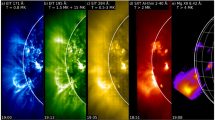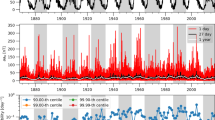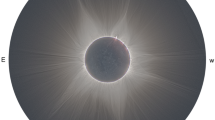Abstract
This paper presents a statistical study of various integrated parameters of solar active regions, such as the distance between the polarity centroids, the inclination of the magnetic axis, the flux imbalance between the polarities, and the interosculation parameter of the magnetic fluxes of opposite polarities. The study is based on observations of the longitudinal photospheric magnetic field. We analyze ten active regions for which an appreciable volume of data with good spatial resolution are available. The distributions of the above parameters with field strength are very different for quiet and flare-productive active regions and for quiet and flare-active evolutionary phases of the same active region. Some distributions exhibit substantial and characteristic variations during the development of certain flare processes. The first moments of the distributions reflect specific features in the configuration of the photospheric magnetic fields and are correlated with the level of eruptive processes in the active regions.
Similar content being viewed by others
References
K. Tanaka and Y. Nakagawa, Sol. Phys. 33, 187 (1973).
E. Tansberg-Hahsen and A. G. Emslie, The Physics of Solar Flares (Cambridge Univ. Press., Cambridge, 1988).
E. R. Priest, Solar Magnetohydrodynamics (Reidel, Dordrecht, 1982; Mir, Moscow, 1985).
T. R. Metcalf, J. Litao, A. N. McClymont, et al., Astrophys. J. 439, 474 (1995).
C. Sawyer, J. W. Warwick, and J. T. Dennett, Solar Flare Prediction (Colorado Assoc. Univ. Press, Boulder, 1986).
P. S. McIntosh, Sol. Phys. 125, 251 (1990).
B. Schmieder et al., Sol. Phys. 150, 199 (1994).
T. Wang, A. Xu, and H. Zhang, Sol. Phys. 155, 99 (1994).
D. P. Choudhary, A. Ambastha, and G. Ai, Sol. Phys. 179, 133 (1998).
N. Nitta, L. van Driel-Gesztelyi, K. D. Leka, and K. Shibata, Adv. Space Res. 17, 201 (1996).
V. S. Gorbachev, S. R. Kel’ner, B. V. Somov, and A. S. Shvarts, Astron. Zh. 65, 601 (1988) [Sov. Astron. 32, 308 (1988)].
T. Wang, Q. Jiong, and Z. Hongqi, Astron. Astrophys. 336, 359 (1998).
S. R. Patty and M. J. Hagyard, Sol. Phys. 103, 111 (1986).
J. Wang, Z. Shi, H. Wang, and Y. Lü, Astrophys. J. 456, 861 (1996).
H. Li, T. Sakurai, K. Ichimoto, and S. Ueno, Publ. Astron. Soc. Jpn. 52, 465 (2000).
D. L. Mickey et al., Sol. Phys. 168, 229 (1996).
B. J. LaBonte, D. L. Mickey, and K. D. Leka, Sol. Phys. 189, 1 (1999).
J. Chen, H. Wang, H. Zirin, and G. Ai, Sol. Phys. 154, 261 (1994).
M. J. Hagyard, J. B. J. Smith, D. Teuber, and E. A. West, Sol. Phys. 91, 115 (1984).
A. Ambastha, M. J. Hagyard, and E. A. West, Sol. Phys. 148, 277 (1993).
H. Wang, M. W. J. Ewell, H. Zirin, and G. Ai, Astrophys. J. 424, 436 (1994).
O. V. Chumak et al., Astron. Astrophys. Trans. 22(3), 335 (2003).
G. Ai, Publ. Beijing Astron. Obs. 9, 27 (1987).
N. Nitta, Astrophys. J. 491, 402 (1997).
O. V. Chumak and Z. N. Chumak, Kin. Fiz. Neb. Tel 3(3), 7 (1987).
O. V. Chumak, Tr. Astrofiz. Inst. Akad. Nauk Kaz. SSR 51, 65 (1992).
O. V. Chumak, É. V. Kononovich, and S. A. Krasotkin, Izv. Ross. Akad. Nauk, Ser. Fiz. 62, 1879 (1998).
O. V. Chumak and H. Zhang, in Solar Variability as an Input to the Earth’s Environment, Ed. by A. Wilson (ESA Publ. Division, Noordwijk, 2003), ESA SP-535, p. 75.
H. Wang, Sol. Phys. 215, 281 (2003).
O. V. Chumak and H. Zhang, Chin. J. Astron. Astrophys. 3(2), 175 (2003).
Solar Geophysical Data. Explanation of Data Reports, No. 515 (Suppl.), 21 (1987).
L. M. Green, P. Démoulin, C. H. Mandrini, and L. Van Driel-Gesztelyi, Sol. Phys. 215, 307 (2003).
Author information
Authors and Affiliations
Additional information
__________
Translated from Astronomicheski\(\overset{\lower0.5em\hbox{$\smash{\scriptscriptstyle\smile}$}}{l}\) Zhurnal, Vol. 82, No. 9, 2005, pp. 847–859.
Original Russian Text Copyright © 2005 by Chumak, Zhang.
Rights and permissions
About this article
Cite this article
Chumak, O.V., Zhang, H.Q. Integrated characteristics of the radial magnetic field in solar active regions during quiet and flare-productive phases of their evolution. Astron. Rep. 49, 755–766 (2005). https://doi.org/10.1134/1.2045326
Received:
Accepted:
Issue Date:
DOI: https://doi.org/10.1134/1.2045326




